This 13 x 8 cm notebook is bound in red leather with the border blind embossed: the brass clasp is intact. The front of the notebook has a label of cream-coloured paper (6.8 x 1.7 cm) with 'Buenos Ayres (city) Beagle Channel Ascent of P. Desire Creek.' written in ink. There is a watermark in some pages, as on p. 43a: 'J. WHATMAN 1830'. The notebook has a total of 112 pages excluding the covers. The first sequence, pages 1a-90a, runs from front cover inwards. The second sequence, pages 1b - 22b, runs from backcover inwards.
[front cover]
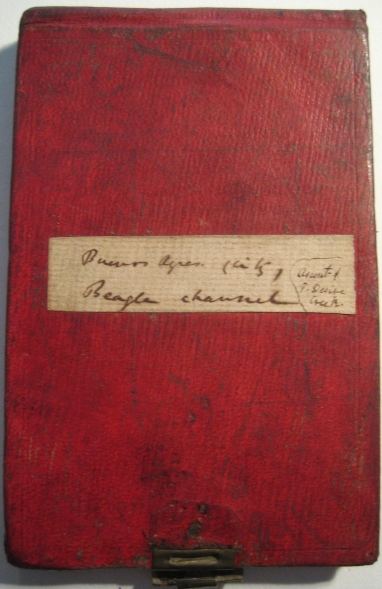
Buenos Ayres (city)
Beagle Channel
ascent of P. Desire creek.
[inside front cover]
C. Darwin
Basker[illeg]
27
3
10
16
5
61
90
25
15
1 158 Calle1 [Victor]
Mr Hughes2
Hargrave
Calle de la puedad
Hill near Fouche Hotel
Calle de la Cathedral
1 Spanish for street.
2 Charles Hughes, a school fellow of Darwin's, attended Shrewsbury School, 1818-19 and resident in Buenos Ayres, 1832-3. See several mentions of him in Correspondence, vol. 1.
[page 1a]
Hargrave
Paper Bramah pens:1 Note book
Scissors
Thin [belt]
Watch key & glass Dentist
Thermometer Bramah Pens
Note book
Watch mended
Mr Chas Hughes Mssrs Rodger, Breed & Co.
Spurs Museum open every 2nd Sunday
St Domingo
Mr Lumb2 to collect shells in Limestone
1 Joseph Bramah (1748-1814), patented a machine in 1809 to cut multiple nibs from a single quill. Bramah pens were the first widely used pens with separate nibs slipped into a holder.
2 Edward Lumb (1804-75), English merchant in Buenos Ayres.
[page 2a]
Owe Mr Rowlett1 one paper dollar
Pay for boys bringing to the Inn
Chaffers2 one paper dollar
The very next door to Mr Griffiths3 a french Dentist
Cigars: Dentist
Mr Griffiths Calle de Florida
Caldcleughs S America4
1 George Rowlett.
2 Edward Main Chaffers, master of the Beagle.
3 Charles Griffith, British Consul at Buenos Ayres, 1834.
4 Caldcleugh 1825. Alexander Caldcleugh (d. 1858), Private Secretary to British Ambassador to Chile, later trader and plant collector living in Santiago. Owner of copper mines at Panuncillo.
[page 3a]
Mr Hammond1 owes me 27 paper dollars
3 hooks
10 Williams
16 riding
50
Dr Browne Union Reading Rooms
Aperea;2 animal without tail or Conejo3 del Campo
Mr Flint,4 owe him 1 dollar + 60
1 Robert Nicholas Hammond (1809-83), temporary mate on the Beagle, who often accompanied Darwin on shore excursions.
2 A guinea-pig, see specimen 1266 in Zoology notes, pp. 164-5; listed as Cavia cobaia in Mammalia, p. 89.
3 Spanish for rabbit.
4 Mr Flint, an American merchant at Buenos Ayres.
[page 4a]
Calle de Victoria
158 Nos. Mr Breed R & Co
Mr Stedman1 opposite theatre Calle de Cangallo: Bookseller
Famatine (Rioja)
Gold & Silver specimens
1 Mr Steadman, a bookseller in Buenos Ayres. See Correspondence vol.1, p. 319 n2.
[page 5a]
Tweedee1
Retiro J Tweedee Tweedee
Public Garden
Retiro Retiro
Mr Rowlett 30 dollar
Mr Edward Lumb: 56 Calle de laPaz
1 John Tweedie (1775-1862), Scottish gardener and plant collector based at Buenos Ayres, who owned a garden at Retiro. We are grateful to Jeff Ollerton for providing this information. See Ollerton, Chancellor and van Wyhe, 'John Tweedie and Charles Darwin in Buenos Aires'. Notes and records of the Royal Society (2012).
[page 6a]
Nov 4th [November 1832] — Sunday — Convents idolatry — gay appearance: Museum, civil manners; rode out in the evening along the beach: Mendoza waggons
5. [November 1832] Went about 6 leagues into the camp[o] — & rode fresh horses back again: open flat country — very green tall thistles. — number of small owls. very like Cambridgeshire from Poplars & Willows
[page 7a]
6th [November 1832] Very busy in collecting informations & specimens shopping. Ladies
7 — [November 1832] Expected to go off wasted the day dined with Mr Gore1 & met the Colonel Vernon:2 great Traveller pleasant evening
1 Philip Yorke Gore (1801-84), Chargé d'affaires in Buenos Ayres, 1832-4.
2 Colonel Francis Venables-Vernon-Harcourt (1801-80). See Beagle diary, pp. 115-116.
[page 8a]
14 14 6 4
84 56 [÷] 8 7
91
Bill 76 paper dollars
I paid 6 silver & 6 paper
I paid 15 silver dollars for horses: having had 2 rides. —
Captain owes me 21 dollars
[pages 9a-12a excised]
[page 13a]
Mr Flint an American Merchant has a tooth: B. Ayres
Pay Rowlett for Boat
El Colonel [Ryuela].
[page 14a]
January 19th [1833]
Entrance of Beagle channel all the mountains & ENE of it rounded — Slate —
at the very Southern entrance there is a large bed, intervening, of a greywacke.1 —
sonorous splintery fine grained siliceous scales of mica (A) &; therefore not covered
ferruginous, decomposing red oval balls of Iron by white lichen & with large angular cleavage like Trap: lines of cleavage dipping at about 80˚ to SSW ∴ running ESE & WNW
other lines not so well marked dipping at same
1 'A conglomerate or grit rock consisting of rounded pebbles and sand firmly united together' (OED). The meaning of this term was changing during the Beagle voyage; Lyell for example implied that it was usually of 'early Secondary' age whereas other authors (e.g. Darwin's teacher Robert Jameson (1774-1854)) implied that it was of Transition age.
[page 15a]
angle to SSE: in the former case almost jasper. the SSW dip is right, shown by the occurrence of rocks distant in channel with same bearing approaching character of slate some miles S of Entrance cliffs of diluvium, the same as formerly, no sign of deposition SSW — sleeping place: slate (B) not very fissile. many lines of cleavage so as to render it impossible to be certain, perhaps
[page 16a]
nearly vertical dipping to SSW. the upper beds at waters edge are banded for long distance with horizontal white lines from preponderance of silex.1 — these stripes are sometimes curved & the planes [inclined] in contrary 2 directions. but generally horizontal. with slight dip to S. — Cleavage is rather parallel to them: Hence I am unable to know any thing about stratification. the hills are not
1 Amorphous silica, such as flint, chert, opal, agate or jasper.
[page 17a]
remarkably parallel to B. Channel & on both sides rounded: started 4 boats, fair wind pretty spectacle. scenery very interesting.
trees & verdur to waters edge: not very luxuriant & few trees. —
Encampement tranquil, smoke, Cove of Islands: few inhabitants:
Accident Robinson:1
1 'Cutfinger Cove. (This name was given because one of our party, Robinson by name, almost deprived himself of two fingers by an axe slipping with which he was cutting wood.)' Narrative 2: 202.
[page 18a]
20th [January 1833] Southern bank rounded hills: [till] Break jaw hills. but between them & channel yet slate hills. — Northern side same only crystalline rocks begin sooner (& at same point come down to water ?) crystalline serrated rocks ridges begin sooner to appear slate from 1st sleeping place to 2d opposite (NE of Break jaw) on each side similar rounded cliffs of white diluvium about 60 feet high generally very similar on opposite sides from observing almost island
[page 19a]
in centre (at 2d sleeping) it is evident these beds stretched across the channel ( same colour on both sides (when above them were different rocks?): not so many boulders as Goree sound & whiter & at 2d break sleeping finer grained & signs of deposition, therefore deposited from more tranquil water
[page 20a]
these cliffs remarkable in scenery: covered with coarse grass:
Southern slate mountains parallel but no parallelism in sides of channell: long pull in boat.— scenery same, astonishment & following of savages wild appearance on hill: naked long hair: (give them many things. slings dinner time)
[page 21a]
attempt to drive them away by fires, innocent naked most miserable very wet
(21st) [January 1833] 5 or 6 miles & close to 2nd sleeping place; North shore fine grained pale — rather fissile slate. (C): containing siliceous beds: cleavage dip about 60° SSW ∴ run ESE: & parallel fissures parallel running NW by N & SE by E N by E & S by W: also nearly horizontal
[page 22a]
lines are seen at the a distance — which [if] there is stratification? the  [sketch of 'jawbone ridge'] Cliff of alluvium on Southern shore extending to North by E of Break jaw & not so far on northern shore wet night yet comfortable
[sketch of 'jawbone ridge'] Cliff of alluvium on Southern shore extending to North by E of Break jaw & not so far on northern shore wet night yet comfortable at starting afraid of fighting with savages women & children retreated signs of great fire:
[page 23a]
[on] side of hill. B. Halls1 Volcano.
•• these horizontal planes dip at small angle to the SSW. in in the rock waving line of pale jaspery slate are parallel to them: (behind the slate ridge is quadrangular hill mountain of crystalline rocks?) This must be strata
• Supplementary ridges about 150 feet high with pebbles
1 Basil Hall (1788-1844), naval captain and explorer. Hall 1824.
[page 24a]
These supplementary and parallel ridges. most frequently by dip to about NE. directly contrary to general mountain. (Von Buch)1
The serrated rocks appeared nearer to shore on Northern bank than on the Southern when so the slate from a straight row of island (∴ these serrated mountains run in a NE direction?)
(D) Serpentine pebbles on the beach
1 Christian Leopold von Buch (1774-1853), pioneering German geologist and palaeontologist. Von Buch 1813.
[page 25a]
Morning — 22d [January 1833]
Last night comfortable & quiet. scenery begins to be beautiful: snow covered mountain: hot day
5 miles W E of Ponsonby Sound a large amphibolic1 formation.
(E) upper beds most [horn stone]
(F) variety with Feldspar
(G) alternating with slate: on the coast 2 or 3 beds of (G) about one yard thick alternate
1 Associated with the amphibole group of silicate minerals, such as hornblende, common in igneous and metamorphic rocks.
[page 26a]
with the slate (H) slate (decomposing red) altered harsher generally cleave cleave dips ∠ 75˚ to SSW. — but near greenstone slightly altered. sides [touching] greenstone parallel — This amphibolic evidently protruded through & rests on slate: country with rounded paps desolate few trees at this place on N shore serrated
[page 27a]
mountains come down to water's edge with exception of chain of (slate?) islands at base height of trees curiously regular reaching nearly to the patches of snow
23d [January 1833] — Morning entrance of Ponsonby Sound — Slate rather fine grained (K) dipping to the East ∠ 23˚ fissures very smooth planes NW by N ∠ 45˚ & others to E by S ½ S ∠ 87˚ cleave to S by W ∠ 50˚ slate contains oval nodules of darker slate
[page 28a]
crossed by many dykes veins of Trap (L) light coloured fine grained slate altered by junction (M) Sometimes where in contact dips ENE
(K) common slate with white bands How much of this difference of dip from the SSW is to be attributed to the Trap: & how much to the serrated chain? (Trap)
[page 29a]
W of Ponsonby Sound after (last night) after quiet delightful pull through the channel smooth water surrounded by peaked mountains between 2 & 300 feet high — the upper parts of which are brilliant with snow & lower dark with green wood found a snug cove: large fire. naked savages around it. Starlight
[page 30a]
large fire: chorus of singers: savages perspired Tekenika J Buttons1 quiet people: after breakfast a large body came over the hill they had run so fast that their noses were bleeding. When we started to go J Buttons place within Ponsonby Sound. — 12 canoes accompanied & from the bright sun & hot day the scene resembled the drawing amongst Pacific isles:
1 Orundellico known as James 'Jemmy' Button (?1816-63).
[page 31a]
we out sailed them & found Jemmy guided us. none of Jemmy's immediate friends were there, but doubtless the news wide spread:
within Entrance (East side) of Ponsonby Sound. slate strata generally dipping southwards & curiously contorted almost anticlinal1 line.
perhaps continuation of Break jaw mountains: North of island & South of W peninsula of Navarin I. the slate generally dips Southwards
1 Up-fold of strata (opposite of syncline, a down-fold).
[page 32a]
The evening spent in cutting wood & clearing ground for Garden — Jemmy Buttons 3 brothers & Mother. J can talk but little: not much affection on Jemmy's part: excellent spot: Guanaco1 — everything favourable — 3 brothers came to meet Captain favourably: Jemmy recognising voice: extraordinary strength of voice:
24th [January 1833] The hands busily employed in building a hut & going on with the Garden:
1 A species of South American llama (Lama guanicoe).
[page 33a]
Savages are quiet. sit in row. naked by the trench: will not much work watch everything: our washing & white skins surprise them most: canoes slings spears fishing, manner of life mi Guanaco in winter: very wet day uncomfortable walked up mountain to shoot Guanaco could not get near to them: large & numerous trees. [many] decayed. — summit a swampy dreary plain.
[page 34a]
25th [January 1833] Slate greyish blue rather fissile O (same as [usual]) dipping at ∠ 53˚ to S by W ½ W. apparently beds; & coloured bands (not white stripes as before) & cleavage all the same: between the beds & ∴ parallel are beds of breccia small bits of slate in a Greenstone base (N) very frequent & forming large masses in the mountains as
[page 35a]
abundant as the slate: both greenstone & slate with flattened oval large 3 or 4 inches cavities: perhaps contained some mineral now washed out P Greenstone with large fragments & passage Greenstone sonorous conchoidal fracture & in natural fissure most parallel & smooth — so as to form very regular quadrangular rhomboidal pieces: alternations of slate & it, frequent well defined: does the slate answer to greenstone as phyllade to mica slate
[page 36a]
Many more Fuegians arrived in their canoes: uncle & friends of Jemmy. very civil painted white. like millers sit quiet watching & begging for everything: never pass the trench.— Is not the amphibolic formation at Eastern Extremity Navarin Is where strata are contorted — signs of anticlinal line. the subterranean agent by which Breakjaw Mountains were elevated does not
[page 37a]
the bearing of chain countenance it? — NB. near anticlinal line strata
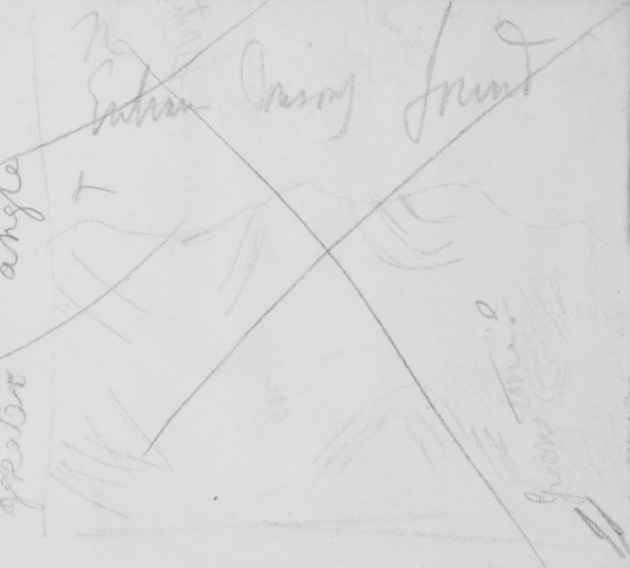
[map of Ponsonby Sound]1
N Entrance Ponsonby Sound Green Stone ?
1 See the fair copy of this sketch in the geological diary DAR 32.98a.
[page 38a]
26th [January 1833] High up slate very fissile (Q) ferruginous cleavage dipping S by E ∠ 70˚ Perhaps from the northerly chain in Hoste Island country. large elevated flattish track with these slate knolls between slate beds (R) trap like angular mass with fragments slate as before
N.B. Beetles on sandy
[page 39a]
plain Heteromerous.1 Bahia Blanca V. De la Beche?2 Arrival of women. above 120 people. men sit watching women work The specimen (P) is part of a mass with prismatic or trap-like cleavage. — & is curious as on one side looking like 2 pieces of slate entangled, on the other a gradual alteration
1 Coleoptera, see Darwin's insects, p. 71 and Zoology notes, p. 128.
2 Possibly a reference to De La Beche 1831.
[page 40a]
if the slate & trap are the same in every thing but form, we must suppose the slate entangled & the greenstone by the contact loosing its crystalline power
27th [January 1833] Near the sea frequent about 50 or 60 alternations of narrow beds: varying in width of slate & greenstone sometimes one
[page 41a]
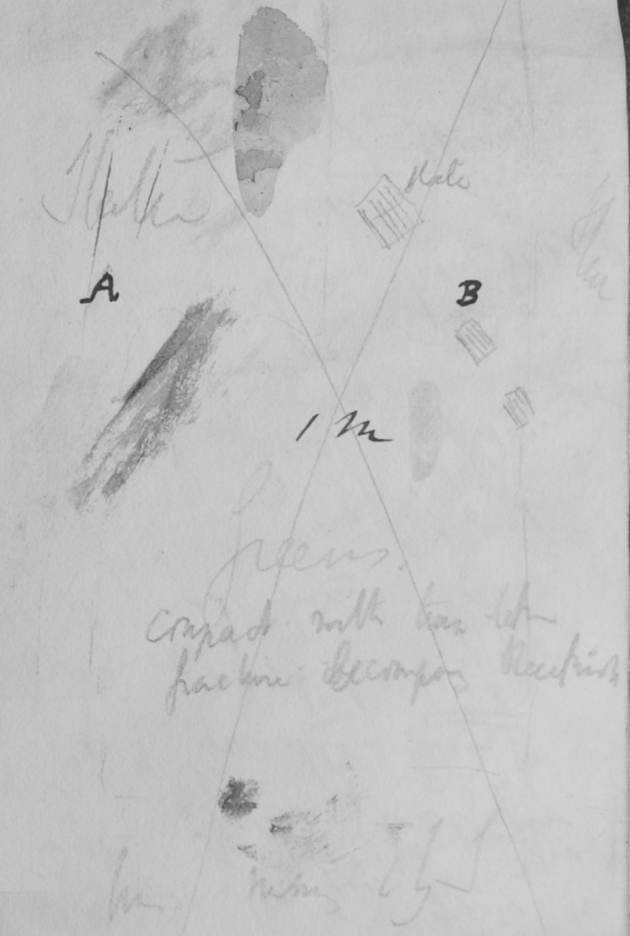
[section of slates]1
Slates slate [illeg] A B Greens. compact with trap like fracture decomposing blackish [lines] running E by S
1 See the fair copy of this sketch in the geological diary DAR 32.93v.
[page 42a]
broadest sometimes another slate indurated decomposing ferruginous greater spec. gravity banded like jasper line of junctions most fine, parallel, straight, could not have been protrusion or deposition: if one place had been only seen. trap appears to have torn from beneath slate. & near it to have entangled & separated pieces so as to give different cleavage lines Vide [(P)]
[page 43a]
9 inches of pure mould over old shells from wigwam Temp of Salt water 55˚ in shade 70˚ uncongenial climate glaciers & no crysomelidae1
• vide Plate (both fact not in one greenstone) the beds run E by S & W by N- & dip nearly vertically to N by E ie exactly contrary
1 Leaf beetles.
[page 44a]
to general character of upper range of hills. Von Buch Some beds not more than 2 feet thick
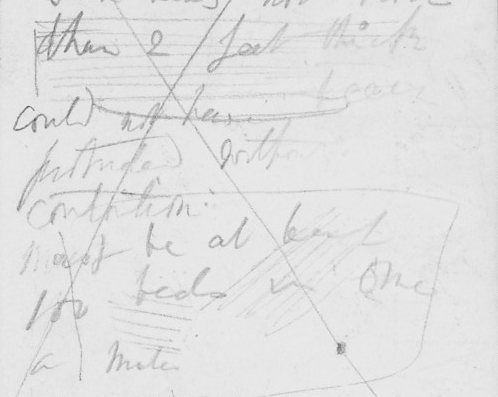
[section of strata]
could not have been protruded without contortion: must be at least 100 beds in only ½ a mile last night two men crawled near tent: return from walk found every woman &
[page 45a]
child & canoes & nearly all men gone: strangers arrived: watched from hill: spears & spot of destination: change of manners: hurry all goods in tent & retreat to little beautiful cove York &c not frightened impossible to judge what was the matter: misfortune: extreme treachery of character. anecdote of Captain last voyage. shark in Cove:
[page 46a]
28th [January 1833] Spider green with eggs enveloped in very strong web brown on a bush Bugs under Bark Settlement: Fringilla1 in flocks. Returned to Settlement, all quite quiet: Jemmy brother & mother returned: sent away 2 bad men: aweful night for Matthews:2 pretty scene: canoes after fishes Entrance of Ponsonby Sound section of mountain curious contorted to the W & N
1 A genus of birds of the finch family.
2 Richard Matthews (1811-93), missionary of the Church Missionary Society on board the Beagle to establish a mission at Tierra del Fuego. This was abandoned in 1833 and Matthews rejoined the Beagle until New Zealand in 1835.
[page 47a]

[sketch section]
NNE SSW 3 or 400 yards
[page 48a]
the prevailing SSW dip appears to hold good but within the serrated ridges are out of all order: — In Beagle Channell mountains not very parallel: about 18 miles northern shore. W of Ponsonby Sound. Mica slate & few miles W of a big Bay & again Green [talcose] schist. — dipping to the South (SSE & SW by W) cleavage contorted involving beds of quartz: all
[page 49a]
the pebbles do. ∴ the probably the neighbouring serrated ridges are of this formation (J Button white limestone) Probably all serrated ridge are thus primitive1 & that on N: shore they come near to water opposite Ponsonby Sound Snow & wood joining rivulets. whales blowing excessively hot
1 Coarse-grained rocks which did not show evidence of having been laid down under the sea. Often incorrectly assumed to be of Primitive age. Re-named hypogene by Lyell. Closely related to Protogine
[page 50a]
Having put up tents (mica slate place) unfortunately a party of 7 Fuegians appeared: perhaps had never seen Europeans. no way of frightening them, only rubbed theirs heads when pistols were fired close to them. & laughed at flourish cutlass: obliged to pack up from these fearless barbarians, fight like
[page 51a]
animals: found in the dark a quiet nook. kept watch. solemn scene till one oclock — distant bark of dog:
— J. Button forget languages not prejudices: not eat land birds only the lower trees change colour of leaf in autumn
(29th) [January 1833]
Just within N. Branch. Mica Slate. Phyllade. Hyalomictite dip SSW.
— angular blocks of Granite:
[page 52a]
about 5 miles within grand formation of Mica slate. small silvery scales (W) with largish dodecahedron garnets, cleavage tortuous serpentine dipping to the SW by S or SSW ∠ 65˚ great numbers of blocks of garnets granite [very] small crystals [as] (also Hornblende & Mica rocks) evidently the peaked summit of mountain (such forms
[page 53a]
I have observed within the serrated ridge) channel [above] 1 & ½ miles wide hills on both side above 2000 feet high & the Southern side the strata are evidently seen dipping to the SSW & formed of
 [chan]
[chan]
[page 54a]
entered N. branch of B channel Scenery very retired many glaciers uninhabited beryl blue most beautiful contrasted with snow: dinner great wave boat &c pack up. grand sight. — enormous block of granite 30 yards [around] oblong in figure about 6 above ground & much below — bordering
[page 55a]
ridge formed of such blo blocks- about 50 60 feet high: glacier cliff to sea about 40 feet: blue by transmitted & reflected light: channell covered with small icebergs miniature Arctic Ocean:
30th [January 1833] (opposite [bite] sleeping place. mica slate & narrow beds of green mica rock dipping to the SW by S
[page 56a]
on S shore at the bend in channell there occurs slate fine grained (roofing slate [gre more modern.] alternating with coarse beds & with beds of dark green greenstone small acicular crystals of Hornblend (X) & beds of white Feldspathic rock (Y) the dip nearly vertically to the SW by W. Is this from the Trap (Yes it is for further back
[page 57a]
all the cleaves) to SW by S 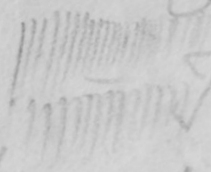 This clay slate formations extends on both sides the
This clay slate formations extends on both sides the be leading bend. — The slate at point where Islands first lazy Bay Southern [(o)] begin are anticlinal & contorted: N shore grand peaked granitic chain: Begins near here apparently beyond greenstone |?| Beyond it again talcose
[page 58a]
schist & phyllade dipping to the SSW — & I suppose old formation — opposite the place (sleeping place). the northern hills not so serrated: How : (Grand views during day. — exceedingly jagged chain snowy clouds, blue sky — scenery generally spoilt by one chain & low point of
[page 59a]
views. — vegetation like Mt Edgecombe.1 Miserable sleeping place big stones putrefying sea weed & middle watch. not all pleasure
(31st) [January 1833] N shore NW of last sleeping place Ph green phyllade — becoming Hornblendic (1). — characteristic [torture] cleavage to SSW. like fire wood channell running [E] ½ N & W ½ S the slate of course ESE & WNW the granite which has
1 Mount Edgecombe, an estate in Cornwall overlooking Plymouth Sound. See Beagle plants, p. 166.
[page 60a]
upheaved the last slate it: Granite small black mica large crystals of quartz (2): hill globular quite barren occurs at a projecting point on N. shore — also (from sight) evidently below the 2 ridges of slate opposite last nights sleeping place. it is seen thus in channell from the latters oblique [le] direction: Again another alternation may
[page 61a]
be seen. — These alternations extend N of the grand Southern entrance from N. Branch into Pacific during heavy rain rather miserable we are now amongst the islands on the W coast called in chart Gordon Island Sleeping place. rock Granite with mica (3) passing into green mineral constituents so arranged as to show tendency to become Gneiss: covered with trees from feldspar
[page 62a]
Feb 1st [1833] Gordon Island very wet. squally true Tierra del. — weather. — 2 Whale within pistol shot enormous backs & tails: resting on [the] the gneiss like granite in Mica slate (dining place) it extends for a considerable dista of the most N side (& I think perhaps central isles yes ): the mica slate fine grained mica black in fine rows [lines] dips to the SW !! Central Islands (the
[page 63a]
main new island). Phyllade (4) (& mica slate (5) or gneiss ?) repeated by alternating & dipping to the SSW: the opposite coast perhaps again granite. extraordinarily barren; all hills on both sides not much elevated the great height ceased where the granite first was touched:
[page 64a]
All country most desolate & quiet: never seen by any European; fur seals: (great accumulation of Boulder from glacier)
Feb 2d [1833]
Few miles W of the slate chain of New Island range of granite, massive form. black mica. hornblende white feldspar & little quartz
(6) small grained this as formerly would appear to intervene between two
[page 65a]
slate ranges: The western extremity entering granite. The Eastern end slate. between 2 ranges of granite & dipping to NNE backwards: The East end of Stuart Isles greenstone the outer line of mountain in this & Londonderry look like granite. I should think this greenstone & porphyritic greenstone abounding with the nearest granite contains hornblende
[page 66a]
Feldspar [was] primitive. During the day been examining some large new islands the furthest point west & channels M Sarmiento. Cold day (Curious little green slate hill surrounded apparently on all sides by bare granite ones) In the granite were dyke & black mica rock Feb 3d [1833] Miserable weather barren [watery] country: outside
[page 67a]
passage rather lucky entered the southern arm of B channel. — the SE end of Londonderry Island. (Phyllade?) having become (7) greenstone slate: 9 miles within B channel both sides pebbles of [near] true granite Granitic greenstone occasional crystal of quartz external forms like Granite (8) has not the form cleavage sonorous sound of Hermit Island: — There would appear to be remnants of slate on [all] islands perhaps washed away:
[page 68a]
Feb 4th [1833] On both sides S. arm of B channell. — granitic greenstone (9). In Feb 3d place there were pebbles with acicular hornblende like Hermit Island. — per contra does not contain pyritic & above reasons. — NS 5 miles from bifurcation this granitic rock occurs mingled with micaceous1 slate & above them
1 Containing conspicuous amounts of mica and so tending to reflect light and glisten.
[page 69a]
appears to be slate: on S side 2 miles from do evidently comes to water edge. with dykes traversing it — (this order of course depends on the run of channell) vegetation & form bespeaks slate at bifurcation true (10) (roofing) very fissile & coloured in bands // to cleavage. — some of the planes tortuous others
[page 70a]
straight dipping (from the nearness of granitic rock) to SW by W — It is probable that this rock runs all along the S side of N arm as on the N side the peaks are not serrated but peaks. ∴ perhaps granitic. the lower ranges having been seen to be mica slate. all slate at bifurcation the tops of mountains had
[page 71a]
coloured bands nearly horizontal. & on S side of N arm there were these bands to a great degree: —
very rainy. in afternoon passed bifurcation could see a great many miles through the channel both ways. nothing interrupted the view:
In the [eel] looking fish slime comes through white spots1
1 Possibly a dogfish see specimen in spirits 840 in Zoology notes, p. 347: '840 F X Dog Fish: Color pale "Lavender purple" with cupreous gloss.— sides silvery do.— above with regular quadruple chain of circular & oblong snow white spots.'
[page 72a]
(5th) [February 1833] 5 miles W of big bay The micaceous slate on the (28th) is the I think certainly the most Eastern which comes down to the channell & it cleaves to the SSE. there would appear to be roofing slate resting on it. — & from this place extends W Easter[ly] On the South bank the whole range is evidently roofing slate: the serrated ridges N of Ponsonby Beagle Sound & W of Ponsonby Sound
[page 73a]
— [Dog jaw] are evidently slate & perhaps only summit of roofing slate as in G Success Bay ? H [Merely] running over same ground in the evening amusing bartering scene for fish:
(6th) [February 1833] W Entrance of Ponsonby Sound.— abundance of Greenstone. dyke traversed by different [qualities]
[page 74a]
Surrounded by slate dipping South. — Trap forming large portion of mountain — cause of irregularity of Mountain range. & as it exists on both sides of the 
cause of it — Subsequent to the SSW dip — for Disappointment with the Fuegians Matthews: East centre of Ponsonby
[page 75a]
Sound. — Slate indurated narrow beds dipping to S. [more] folded & contorted traversed by vertical dyke of decomposed Trap-like clay: on one side beds upturned from the Southerly inclination to running
N & S —
This same slate truly near [bare] mountain dip vertically to SSW. & has fissure dipping to NW by S ∠ 65˚. flinty blue slate
[page 76a]
Is not Tierra del the Ultima Thule.1 not volcanic occurrence of garnets in mice slate
[G] SW end of Navarin Island Greenstone (perhaps altered slate). Greenstone every specimen different irregular. [rubbly] fracture. decomposing not highly crystalline containing pyrites2 — some specimens very fine grained. other
1 Meaning a distant place located beyond the borders of the known world.
2 Usually iron pyrites, iron sulphide, common in slates, but can be other sulphide minerals.
[page 77a]
largely porphyritic with white Feldspar. —
The greater part of Hoste Island appears to be slate is this greenstone — (no Feldspathic rock?
Perhaps Pack saddle I. from its angular shape is greenstone of the Hermit [Group]
In the evening followed by Savages.
[page 78a]
fired over them & frightened them away found a quiet little cove on outside coast fire surrounded by trees:
7th [February 1833]. —
From E W of an Island of S. coast of Navarin Island: a [trench] of L of [diluvium] common & [illeg]
[page 79a]
& in an ENE direction [illeg] the Island In Goree Sound the cleaving & coloured band — dipped vertically to SSW & believe with a degree of other side distant about 34 miles:
[page 80a]
length 1 handkerchief & ½ circumference handkerchief — 3 & ½ inches — Tail —
AA beneath B
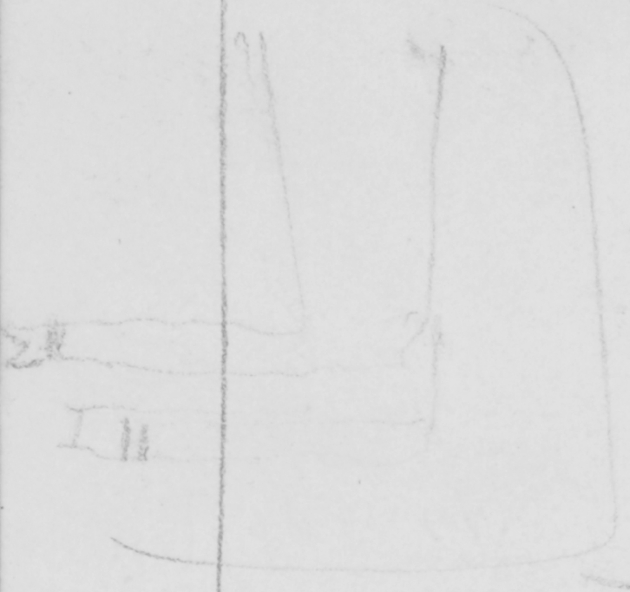 |
[leg of guanaco]1
60 ½ extremity of claws to joint |
1 A footnote in Darwin's Animal notes, 30v reads: 'NB. I have dimensions of Specimen shot at Port Desire, especially about the foot, to compare with those killed in T. del Fuego, which are supposed by some to have broader feet.' See Zoology notes, pp. 182-3.
[page 81a]
Most wide part of sole. 1 & 3/8 inch of foot 2. 7/8 in. — 170 minus inside [7] feet long tip to tip circumference of chest 4ft 8in. Tail Ibis1 iris pink & legs do. — stomach scropions cicadæ Lizard.
Coleoptera2
ENE. 300
1 Specimen 1773 in Zoology notes, p. 186, 'Ornithological notes', pp. 229-30; listed as Theristicus melanops in Birds, pp. 128-9.
2 Beetles.
[page 82a]
At Fort Sea 30.303. Temp 65.7
Shells 30.138. Tem 71.5
Plain of fort of 2 hills 30.030 Temp 70.7
shells [at] sea 30.283 T 72.7
One Carrancha1
Avecasina2 on desert plain

Foot : bed of free stone earthy looking rock yet with crystalline particles
A |
B |
C |
D |
o 1 |
o 3 |
|
|
o 2 |
o 4 |
o |
o |
|
o 5 |
8 |
9 |
|
o 6 |
|
|
|
o 7 |
|
|
1 Possibly the crested caracara, a falconoid bird of prey, see Zoology notes, p. 212; listed as Polyborus brasiliensis in Birds, pp. 9-12.
2 A woodcock (Scolopax paraguayae). 'In la Plata the Spaniards call them 'Avecasina'', 'Ornithological notes', p. 212.
[pages 83a-84a excised]
[page 85a]
yellow lines like water lines in Sandstone. (V2). These rocks instead of being modern beds are subordinate to great Porphyry (1 & 2) 2 is inferior to one — 4 5 6 7 are all beneath the porphyry (3) — These rocks pass into each are so soft as to [resemble] earth & lined with yellow lines. — The porphyry (3) is only bed 9 & 10 feet thick, a superincumbent
[page 86a]
becomes 8. — then 9 both very sonorous, the latter with linear arrange[ment] of constituents about horizontal. — The bed of soft rock dip about 12 10° somewhere near to S or SSE — & superincumbent porphyry do These rocks rest at foot of great porphyry range of hills lower than plain running
[page 87a]
ENE WSW. — origin evidently igneous1 over aqueous Scorpion eating other scorpion.2 —
(27 29th?) [December 1833] on the South side 8 miles up white calc: sands covered by thin bed of hard ferruginous sandstone lying above upon A & B varieties semicrystallized of porphyry: cliff land much subject to diluvium action, excessively solitary. delightful walk reflecting how many hundred years has been. how many will be
1 Rocks formed from the molten state (literally by fire), either 'intrusive' e.g. granite, or 'extrusive' e.g. basalt.
2 The 'cannibal scorpion' referred to in a footnote of Journal of researches, p. 194.
[page 88a]
without tree sublime or animal excepting Guanaco which stands sentinel to its herd: bits of primitive rock scattered about. seen in the vallies: —
highest hill SW by W compass.
28 29th [December 1833] mud banks good eye sight of Guanaco. —
river! horse! many varieties of porphyry fragments & crystals: high cliffs, almost ended vallies. sublime view fine colour of rocks (D) —
[4] specimens
[page 89a blank]
[page 90a blank]
[back cover]
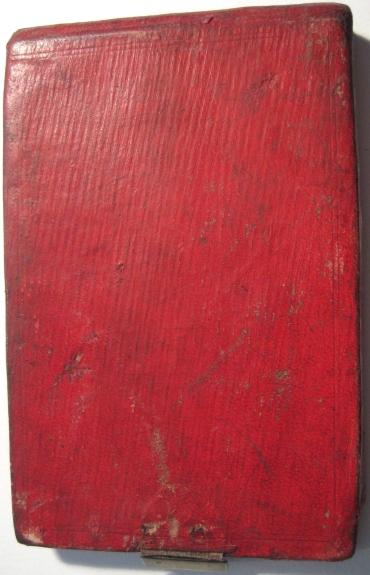
[inside back cover]
For the pistol 6 & ½ Buck shot. — Captain
8 for the Gun
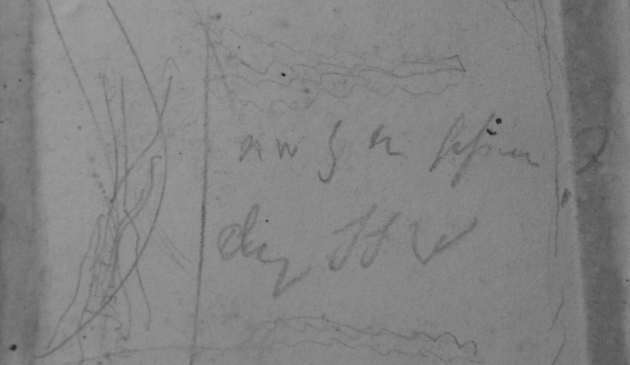
[geological section with fissure]
NW by N fissure? dip SSW [S/M. s] [silty] green [idem look] schist
[page 1b]
[Mr] M Rio Parana waters very black: [R]: m Rio Negro black medicinal qualities excellent drinking sarsapanlle1 Mr [Hujet] Water pale (Both say) of Uruguay in latitude 32˚ — Palm Forest
Sarsaparilla, a species of Smilax, a perennial vine used for medicinal properties. Its name derives from the Spanish words zarza for 'shrub' and parrilla for 'little grape vine'.
[page 2b]
it is said that Crocodile occur & small water turtles. — silicified ([stink] fire) wood: Lime said to be had at Aroya de la China: some shells St Jago de Estero felt was was quite overthrown in an Earthquake not within in memory of man
[page 3b]
Tosca thick town built on it — cut into vallies — red compact — with nearly houses little inclined beds of (soft siliceous Limestone?): lines of fracture separated & filled up by the Tosca: stops water wells dry to the surface or some little way out it
[page 4b]
November 1st [1832] Very calm delightful days: quietness seems to shorten the distance. always think of home Nove[mber] 2d [1832] Anchored at 3 am before noon in the roads. We passed our friend the Guards ship. who this time knew better than to fire at us. — Landed & were carried in carts on shore — went out riding &
[page 5b]
walk about the town. —
November 3d [1832] B Ayres large city: [much] regular streets
(handsome plaza viceroys)
Quadras & square houses: — number of excellent shops: general European appearance excepting a few Gauchos.1 —
Spanish ladies beautiful dresses & walk went out riding
1 A mixed European and Indian race of equestrian herdsmen of the South American Pampas.
[page 6b]
bad roads, good horses; hedges agaves & fennel — — flat enclosed country — ditches. most uninteresting. —
Saw Bullock killed: the feeling of being on shore very pleasant: Rock which rings at Rio Negro. Trap? or thereabouts ie in B Ayres
Fresh water shells at Ensenada: — ?
[page 7b]
Fresh water shells in the rock, above level & some distance from the present river burnt for lime Ensenada Also on the coast opposite to Mr Lumb estancia Mya1 &c living ones
1 A genus of soft-shell clams.
[page 8b]
Stone from the mole comes from Martin Garcia & Colonia. Syenite mica slate. Greenstone large crystals & slaty Hornblendic rock with crystals & Feldspar &c &c.
Spurs. Dentist Hughes Frenchman & Curiosities.
Mr Chaffers do. — [Botanical]
Captain The cliffs specimens.
Mr Lumbe (? direction & shells in Lime)
[page 9b]
Mention about the animals being only skinned & snakes [Lizards] &c &c
Is M. Video built on granite or the Gneiss?
[page 10b]
Spix. Abrolhos. 120P.1
Will the gradual deposit of river explain the Tosca.
John Meggett Messrs. Messrs Brittain & Co. Buenos Ayres.2
The Estancia de los Yuquerises Entre Rios
Desert of Atacama 25 Leagues from the Port
1 Spix and Martius 1824, 1: 120, discussed the Abrolhos Islets.
2 "J. Megget" was Clerk on the first voyage of the Beagle and is mentioned by P. P. King in Narrative 1, pp. xiv and 376 and by Darwin in CUL-DAR 32.83-84. and CUL-DAR42.109.
[page 11b]
of Cobija — alias La Paz great Iron Formation connection with Volcanic action
At San Antonio de [Arico] distant from Buenos Ayres 30 leagues: the water has power of turning small bones into large ones.
Agraciado. Banda Oriental. 15 leagues from Martin Garcia. small shells are burnt for lime: —
[page 12b]
(a): Granitic undulating chain of hillocks. running North & South
Bramah pens: Stirrups. Note books
Calle de Porton
— Watch mended
— Great teeth
— Information about whale.
— Joiner What M. Video built on ?
[page 13b]
Oakley1 a joiner. with red hair: Monte Video: Can be heard of at an Hotel formerly kept by Browne:
Casks: length of
red cloth: Lamb well & teeth
Mr Fitus Hotel Calle de St Felipe
[Turtle]
1 Oakley was the agent of Woodbine Parish (1796-1882), the British consular representative in Buenos Ayres, see Winslow 1975.
[page 14b]
South of Rio Negro cliffs of Tosca — [La] Paz?
15 miles above Pisandu Limestone near Arora de la China: Above Arora del [Palma] near Segnor Manuel Esquenaga
teeth belonging Mad Barboza Buenos Ayres
Teeth found at Salto between near head of Rio Arrecife &
[page 15b]
[arrecos] ?)
Viscache1 shit as dogs
There is a small Villa at Luxan near B Ayres (Oakley)
Gypsum2
Directions parchment & paint.
Custom House
Mr May3 Hammer & [tools]
 [sketches of tables]
[sketches of tables]
1 A burrowing rodent related to the chinchilla which resembles a large rabbit, but with bigger gnawing teeth and a long tail and three toes behind like the agouti. It is common in the pampas in the neighbourhood of Buenos Ayres; see specimen 1442 in Zoology notes, pp. 180-1; listed as Lagostomus trichodactylus in Mammalia, p. 88, and spelled as 'Bizcacha' (elsewhere spelled 'Viscacha' or 'Biscatcha' by Darwin).
2 Hydrous calcium sulphate, often in the form of crystals (selenite). Darwin explained that in Chile gypsum was called 'Padre de la sal', while potassium sulphate ('potash') was called 'Padre de la sal'.
3 Jonathan May was the Beagle's carpenter.
[page 16b]
Ask Henslow1 open Pill boxes — Seeds Mr Stokes Washing clothes Capinchas dung smells very sweet — On Friday Gossamer web Conjuror Hammer
1 John Stevens Henslow (1796-1861), Cambridge botanist and mineralogist, Darwin's scientific mentor when at Cambridge, who received and preserved Darwin's Beagle specimens during the voyage.
[page 17b]
Settle with Fuller1 No jars or paper washing Bull 90 Cooper 10
83:1
3:4
5.4
24
____
116.0
48
____
68
1 Harry Fuller, Captain's steward on the Beagle.
[page 18b]
Owe Hamond1 30 (1) [Had me 2] silver dollars Row[l]ett 4 Owe Hammon[d] as balance 21 Dollars. Rowett 4 Black Duck Plus Boro ; Borr 1 & Dinner. Covington2 Trousers Drawers & shirt. Good Success. Bay. dip to West
1 Robert Nicholas Hamond (1809-83), mate on HMS Druid, loaned to the Beagle in November 1832, and returned to England in May 1833.
2 Syms Covington (1816?-61), 'Fiddler and boy to the poop cabin' on Beagle's second voyage, he became Darwin's personal servant from 22 May 1833 until 25 February 1839.
[page 19b]
at small angle.
Owe Peterson1 knife net.
(John < >
1 John Peterson (1787-?), Quarter-Master on the Beagle.
[page 20b blank, partly excised]
[pages 21b-22b excised]
Textual notes for the Buenos Ayres notebook
[IFC] 1.12] Down House number, not transcribed.
88202332] English Heritage number, not transcribed.
C. Darwin] ink.
[6a] eight marks in ink on this page may be the testing of a nib.
[24a] this and the facing page are very dirty.
[38a] an ink mark appears to be the testing of a nib.
[40a] there is a watercolour stain on this page.
[41a] there are watercolour stains and apparent ink nib tests on this page.
A B] ink.
[IBC] 2] added by Nora Barlow, pencil, not transcribed.
[1b] 3 ink marks near 'Negro' appear to be nib tests.
[10b] John...Post] not in Darwin's handwriting.
[11b] of Cobija... Paz] not in Darwin's handwriting.
[15b] sketch drawn perpendicular to the spine. Gypsum] ink.
[19b] rest of page excised.
[The Beagle field notebook identifiers were re-set in January 2021 meaning the page counters were reset to 0. At that time this notebook had 19287 visits.]
 REVISION HISTORY: Scanned by Historic England. Transcribed from microfilm by Gordon Chancellor; transcription typed and checked against microfilm by Kees Rookmaaker, 5.2006. Corrected by Chancellor 5.2006. Further editing and corrections by John van Wyhe 9.2006; checked against the manuscript by Chancellor 3.2007, corrected against colour photographs by John van Wyhe 5-7.2007. Transcription revised and edited by John van Wyhe 6-12.2008, 2024. RN17
REVISION HISTORY: Scanned by Historic England. Transcribed from microfilm by Gordon Chancellor; transcription typed and checked against microfilm by Kees Rookmaaker, 5.2006. Corrected by Chancellor 5.2006. Further editing and corrections by John van Wyhe 9.2006; checked against the manuscript by Chancellor 3.2007, corrected against colour photographs by John van Wyhe 5-7.2007. Transcription revised and edited by John van Wyhe 6-12.2008, 2024. RN17









 [sketches of tables]
[sketches of tables]